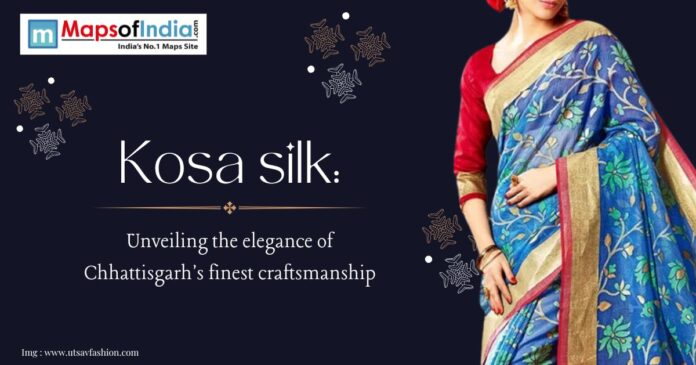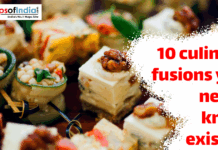Kosa silk is the finest form of craftsmanship of Chhattisgarh. It’s a craftsmanship developed in Chhattisgarh. This golden-hued Tussar silk boasts a unique texture. This craftsmanship was developed in Champa and Korba, and it is done from wild silkworms. In recent years, it has become a leading sustainable fashion trend. A recent Fibre2Fashion report called this craftsmanship eco-friendly and forest-woven. Most artisans are tribal people living here, and they create stunning sarees and garments. The cultural roots of this craftsmanship are tied to ancient traditions. Kosa silk has captivated global attention due to its beauty and eco-friendly nature.
Ancient Origins and Tribal Legacy
The roots of Kosa silk production are deeply rooted in the history of Chhattisgarh. This silk is a variant of Tussar silk, and is obtained from Antheraea mylitta silkworms. These silk-producing worms thrive on Arjun, Sal, and Saja trees. The term “Kosa” is derived from Sanskrit, meaning cocoon. According to a recent study, it has been noted that Champa pioneered its craft. Mughal royals really liked the golden sheen developed from this silk. This silk was used in princely courts. We can find the traces of its export in international markets from British colonial records from the 1800s. Tribal communities like the Gond and Baiga mastered this craft. In tribes, this silk is used to adorn wedding sarees. Tribal people obtained raw material from the forest. Wearing Kosa silk symbolised wealth and prestige. Its legacy reflects India’s sericulture heritage..
Intricate Production Process
Kosa silk production is artisanal. The process of obtaining silk begins with silkworm rearing in forests. Worms spin cocoons on trees for over 25 to 30 days. After that process, an estimated 5 to 10 kg of silk is obtained per hectare. After the cocoons are made, cocoons are boiled to extract the threads from them. Sometimes, most of the hand-reeling is done by women. The obtained threads are dyed with natural colours. Roots, flowers, and lac create vibrant hues. These eco-dyes help the product to long long-lasting and due to this, are in demand with eco eco-friendly market. Weaving needs pit looms to get precision. Artisans create motifs like peacocks and lotuses. Polishing adds the signature shine. To make a complete saree from this silk, it takes 15 to 20 days. No heavy machinery is used in this process. Quality checks ensure durability. The process preserves tribal skills. Kosa’s texture sets it apart.
Eco-Friendly Materials and Sustainability
Kosa silk is an eco-friendly material and is sustainable. Silkworms feed on wild trees, avoiding pesticides. This is a forest-based production. Cocoons are collected without killing any worms. The threads obtained for this are 100% biodegradable. To colour these threats, natural dyes from turmeric and indigo are used, which reduce pollution. Water use in this process is also minimal. Unlike cotton, it needs little irrigation. Zero waste is generated during the process of weaving. Scarves or stoles are made from the leftover threads. The kosa silk obtaining process needs low investment. This benefits local rural economies. Kosa’s green credentials attract environmentally friendly buyers. This is a model for sustainable textiles. Its organic nature drives global demand.
Cultural Significance in Chhattisgarh
Kosa silk has become Chhattisgarh’s prideful identity. This is central to tribal rituals. Motifs reflect nature and mythology. Many symbols are waved using this silk, like Peacocks symbolise grace, while lotuses symbolise purity. Sarees adorn brides during weddings. The work made from kosa silk is really famous in local festivals. Women gift Kosa to honour traditions. Natural dyes are used to colour the silk. It’s one of the long-lasting practices that is still followed. These preserve ancestral customs. Tribes like Gond and Kanwar are key artisans. Kosa is a cultural bridge. It unites many local tribal communities. Some believe it carries spiritual weight. Worn in temples, it signifies devotion. Kosa embodies Chhattisgarh’s heritage. Its elegance tells stories of pride.
Economic Impact and Empowerment
Kosa silk has changed Chhattisgarh’s local economy in a positive way. Over 100000 families from Chhattisgarh depend on it. Women are the main part of the workforce, and they earn steady incomes for their families. A single saree is sold for Rs. 3000-10000. The kosa silk industry grew from Rs. 500 crore in 2020 to Rs. 800 crore in 2025. These products are exported to the US and Europe. These products are in high demand for their eco-textiles. Handloom clusters come from Champa and Korba. Government schemes provide support in local communities and also training for the youngest. With the use of e-commerce platforms, sales increased by 30%. Kosa reduces rural migration. This empowers women in local communities, making them self-sustaining. Artisans gain financial independence. Kosa is a lifeline for rural Chhattisgarh.
Modern Adaptations and Global Reach
Kosa silk has embraced modern fashion with the changing times. Artisans use cotton for lighter fabrics. Nowadays, eco-friendly dresses and kurtas are also produced here. Designers create scarves and blouses. Fusion products are made with block prints. Platforms like Kosala sell, sell these products to global buyers. The product made from Machine-assisted speed up the production process by 20%. Training programs teach modern dyeing. There are many women-led cooperatives that teach production to the young generation. Kosa graces international runways. Nowadays, the prices of Kosa products range from Rs. 5000 to Rs. 50000. These innovative ideas keep Kosa relevant in the market. It balances tradition with style.
Challenges and Preservation Efforts
Kosa silk faces modern challenges. The shift in climate change disrupts silkworm cycles. According to a recent study, it has been found that erratic rains cut yields by 15%. This synthetically produced silk needs to compete with lower-priced mass products. Artisans earn a really low income of Rs. 200 to 300 daily. Not getting paid enough for their work. Young artisans are migrating to cities. Skill training of the younger generation is needed. Government subsidies fund looms.. NGOs like Kosala Revive are focused on using natural dyes. The kosa silk obtained the GI tag in 2009, which vouches for and protects authenticity. This tag raises the product’s value by 25%. Preservation ensures Kosa’s legacy. It safeguards Chhattisgarh’s craft.
Conclusion
Kosa silk is Chhattisgarh’s golden gem. This technique of silk formation has ancient roots that are tied to tribal traditions. These silk products are created from wild silkworms and handlooms. Natural dyes are used to ensure their sustainability. Cultural motifs carry spiritual weight. This art has empowered rural women economically. These modern designs have reached global markets. Challenges like climate change still exist and are affecting this craftsmanship. Preservation efforts are underway to keep this craft alive. In recent years, Kosa silk has shone in the fashion industry on a global level. Buy authentic pieces from Kosala or WeaverStory to support local craftsmen. This silk weaves heritage and elegance. Kosa silk is Chhattisgarh’s timeless pride.




